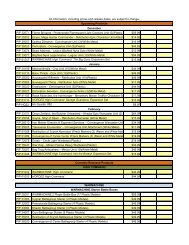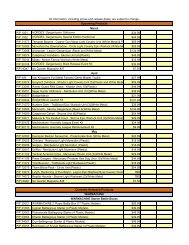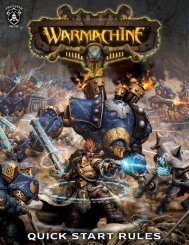Hordes MkII Quick Start Rules - Privateer Press
Hordes MkII Quick Start Rules - Privateer Press
Hordes MkII Quick Start Rules - Privateer Press
Create successful ePaper yourself
Turn your PDF publications into a flip-book with our unique Google optimized e-Paper software.
intrODuctiOn<br />
Take control of a powerful warlock and wreak havoc on your foes with a<br />
horde of hulking warbeasts fueled by unbridled rage. In HORDES, only<br />
the strongest, fastest, and most cunning will survive—the rest are a feast<br />
served up for your warbeasts.<br />
HORDES is a fast-paced and aggressive 30 mm fantasy tabletop<br />
miniatures combat game set in the wilds of the Iron Kingdoms.<br />
Players jump into the action controlling powerful warrior-sorcerers<br />
or battle-shamans known as warlocks. While warlocks are formidable<br />
combatants in their own right, their true strength is drawn from their<br />
parasitic synergy with packs of savage warbeasts—large and monstrous<br />
creatures of flesh, blood, muscle, and bone—that allow the warlocks to<br />
contend on equal footing with the greatest modern armies of the Iron<br />
Kingdoms. Players collect, assemble, and paint fantastically detailed<br />
models representing the varied beasts, minions, and warriors in their<br />
horde. This book provides rules for using those models in brutal<br />
and visceral combat. This is monstrous miniatures combat, and your<br />
tabletop will never be the same!<br />
HORDES focuses on the wilder forces of the Iron Kingdoms. These<br />
<strong>Quick</strong> <strong>Start</strong> rules use cards from four HORDES factions and are designed<br />
to get you up and running with the contents of your battlegroup box set.<br />
They are streamlined to make it easier to learn the game’s fundamentals,<br />
so they omit some special rules and options. HORDES: Primal Mk II<br />
provides greatly expanded rules covering additional models including<br />
troops and characters as well as extensive background for the world of<br />
the Iron Kingdoms.<br />
HOrDes <strong>Quick</strong> start rules<br />
MODels & Materials<br />
WarlOcks<br />
A WARlOCk is a tremendously powerful sorcerer, shaman, or druid with the ability to<br />
control a group of warbeasts telepathically. A warlock is a deadly opponent highly skilled in<br />
both physical combat and arcane spellcasting. A warlock can force warbeasts to attack with<br />
greater accuracy, perform exceptional feats of strength, and launch deadly special attacks,<br />
all of which generate FURY. During a confrontation the warlock can leach this fury from his<br />
warbeasts and use it to boost his combat abilities, heal himself or his beasts, transfer his own<br />
injuries onto warbeasts, or cast formidable spells. A warlock can also tap the dormant innate<br />
power (called the “animus”) of the warbeasts brought to battle.<br />
Warlocks are both the tie that binds the horde and its weakest link. If a warlock falls, his<br />
warbeasts lose interest in the fight and head home.<br />
DESTROY YOUR OPPONENT’S WARlOCk TO WiN THE GAME!<br />
Warbeasts<br />
Warbeasts are mighty creatures born or trained to fight and drawn from the wilds of the<br />
continent of Immoren: deep in the forests, mountains, frozen tundra, or desert wastes. They<br />
are smarter than animals but more primitive and savage than the cultured races leading the<br />
battles across the face of Immoren. Each of the armies in HORDES brings distinct types of<br />
warbeasts to their battles and employs specialized techniques in recruiting and controlling<br />
them. Once warbeasts are brought to fight, the fury of their attacks strengthens their warlocks,<br />
and together they create an almost unstoppable synergy.<br />
Warbeasts would be termed the most terrible of monsters by civilized nations, for each is<br />
capable of ripping a dozen armed men limb from limb. Many have had their considerable<br />
natural abilities enhanced by being outfitted with heavy armor and the best-made weapons<br />
their warlocks can find. Most have endured considerable training to capitalize on their<br />
abilities and fight ably alongside both warriors and warlocks. Though warbeasts are capable<br />
of acting on their own, a warlock’s dominating will overrides their individuality in all but the<br />
most dire of circumstances.<br />
stat carDs<br />
Every model comes with a stat card that provides a quick reference of its profile and abilities.<br />
The primary card’s front shows the model’s stats, abilities, and damage track or damage<br />
spiral, while ability explanations appear on the back. Warlocks have a second card that<br />
describes their spells and feat. We recommend you place each card in a plastic card sleeve or a<br />
sheet protector, found in most game and hobby stores, so you can mark damage on the plastic<br />
sleeve with a dry-erase marker to avoid damaging the card itself.<br />
OtHer Materials yOu Will neeD<br />
In addition to card protectors, you will need a handful of six-sided dice, a flexible ruler or tape<br />
measure, and some tokens (coins or glass beads are fine) to represent focus points and spell effects.<br />
FunDaMentals<br />
MODel stats<br />
To the right of the warlock or warbeast picture, the first stat line represents that model’s<br />
combat capabilities.<br />
SPD, Speed – A model’s movement rate. A model moves up to its SPD in inches when making<br />
a full advance.<br />
STR, Strength – A model’s physical strength.<br />
MAT, Melee Attack – A model’s skill with melee weapons.<br />
RAT, Ranged Attack – A model’s accuracy with ranged<br />
weapons.<br />
DEF, Defense – A model’s ability to avoid being hit by an<br />
attack.<br />
ARM, Armor – A model’s ability to resist being damaged.<br />
FURY, Fury – FURY determines a warlock’s control area and<br />
beginning fury points. A warbeast’s FURY is a measure of<br />
how much the warbeast can be forced.<br />
lYlYTH<br />
SPD STR MAT RAT DEF ARM CMD<br />
7 4 5 7 16 14 8<br />
Hellsinger<br />
RNG ROF AOE POW<br />
12 2 — 12<br />
Bow Blade<br />
POW P+S<br />
3 7<br />
THR, Threshold – The measure of difficulty of controlling a warbeast. Warbeasts with lower<br />
THR are more likely to frenzy. (Only warbeasts have a THR stat.)<br />
WeaPOn stats<br />
Below the model stat line, weapon stat lines show the strength and special attributes of each<br />
weapon that model carries.<br />
or Type: The green gun symbol denotes a ranged attack weapon, and the brown sword<br />
symbol denotes a melee attack weapon.<br />
RNG, Range: The maximum distance, in inches, a ranged weapon can be used against a<br />
target.<br />
ROF, Rate of Fire: The maximum number of times a ranged weapon can be used in a turn.<br />
AOE, Area of Effect: The diameter, in inches, of the area of effect of a ranged weapon’s<br />
attack.<br />
POW, Power: The base amount of damage a melee or ranged weapon inflicts.<br />
P+S, Power plus Strength: For quick reference, the sum of a model’s melee weapon’s POW<br />
and its STR.<br />
aDVantages & WeaPOn Qualities<br />
Immediately below a model’s stat line or weapon’s stat line are a number of icons that<br />
represent common game rules.<br />
Reach – This weapon has a 2˝ melee range.<br />
Stealth – Ranged and magic attacks declared against this model when the point of origin<br />
of the attack is greater than 5˝ away automatically miss. This model does not block line of<br />
sight when determining line of sight from a model greater than 5˝ away.<br />
Tough – When the last damage box of this model’s damage track is marked, roll a d6. On<br />
a 5 or 6, this model heals 1 damage point and is knocked down.<br />
These same icons are used to represent common rules within spells and abilities.<br />
The remaining icons ( , , , , and ) are not used in these <strong>Quick</strong> <strong>Start</strong> rules.<br />
In addition to icons, models’ cards also contain the full text for their less common HORDES<br />
abilities.<br />
Each warlock also has a feat, a powerful ability unique to him. A feat can be used once per<br />
game at any time during the warlock’s activation.<br />
starting tHe gaMe<br />
After setting up the battlefield, both players roll a d6. The high roller chooses who goes first.<br />
The first player deploys his battlegroup up to 10˝ in from a table edge, and then his opponent<br />
does the same. These battlegroups should be deployed on opposite sides of the battlefield<br />
with at least 20˝ separating the opposing forces.<br />
HORDES battles are fought in a series of game rounds. Each game round, both players take a<br />
turn. The player who deployed his army first takes his turn first every game round. After the<br />
second player takes his turn, a new game round begins. A game effect with a duration of one<br />
round expires at the beginning of the current player’s next turn.<br />
The player turn is divided into three phases:<br />
Maintenance Phase: Remove any effects that expire on your turn. If any of your models have<br />
more fury points than their FURY stat, remove any excess fury points.<br />
Control Phase: During the Control Phase, perform the following steps in order:<br />
1. Your warlock leaches fury points up to its current FURY from warbeasts in its battlegroup<br />
in its control area as described below under Leaching.<br />
2. Your warlock can spend fury points to upkeep spells as described below under Upkeep<br />
Spells.<br />
3. Make a threshold check for each of your warbeasts with 1 or more fury points left on it.<br />
Any warbeasts that fail the check immediately frenzy as described below under Threshold<br />
& Frenzy.<br />
Activation Phase: Activate your models in any order. Each model can move and then make<br />
a combat action.<br />
Fury<br />
Warlocks begin the game with a number of fury points equal to their FURY stat, and warbeasts<br />
begin the game with 0 fury points. During the Activation Phase, warlocks can spend fury<br />
points, and warbeasts can be forced to gain fury points. During your Control Phase, your<br />
warlock replenishes his fury points by leaching fury from the warbeasts in his battlegroup,<br />
which simultaneously gives him more fury to spend and his warbeasts greater capacity to be<br />
forced. Warlocks can spend fury points only during their activations.<br />
A warlock can force his warbeasts or leach from those warbeasts only if they are in his control<br />
area. This control area covers 360°, to a distance equal to twice the warlock’s FURY in inches.







